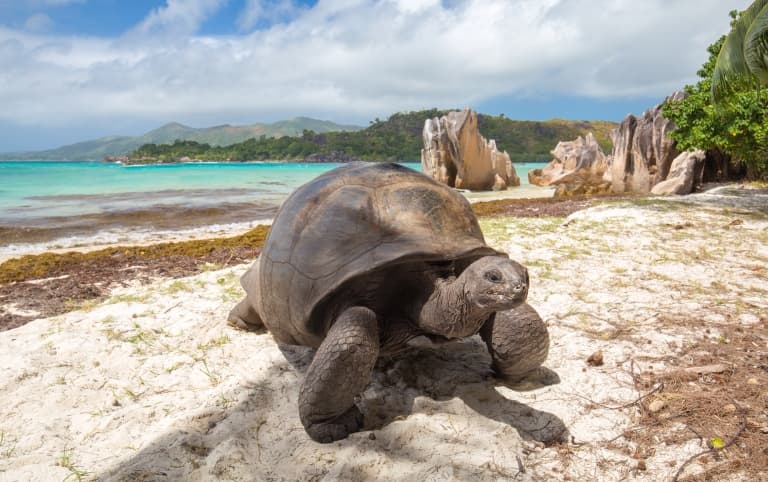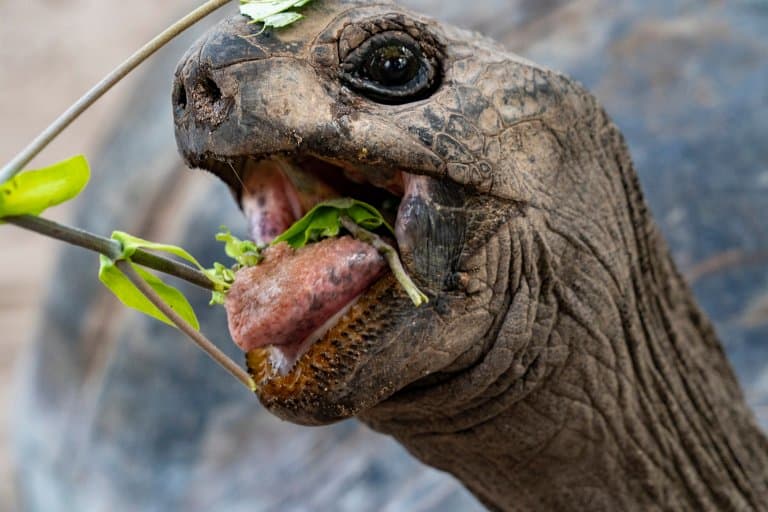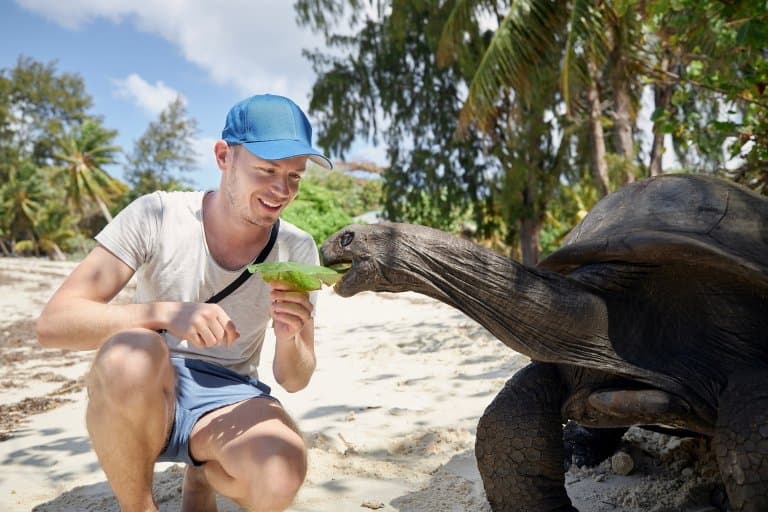Aldabra Giant Tortoise Profile
Reptiles are a funny bunch, they range from tiny to enormous, lightning-fast to sluggish and dumpy, and come in all shapes and sizes. Perhaps one of the weirdest is also one of the most sluggish and heavy.
On a few distant islands, far off the coast of Madagascar in the Seychelles, there’s a species of tortoise that may be the heaviest free-roaming reptile. The Aldabra Giant Tortoise is so rotund it engineers its own ecosystem.

Aldabra Giant Tortoise Facts Overview
| Habitat: | Predominantly coral Atoll, on unique ‘tortoise turf’ |
| Location: | Seychelles |
| Lifespan: | Probably up to 255 years |
| Size: | 120cm (47 inches) long |
| Weight: | Up to 305kg (672lb) |
| Colour: | Brown |
| Diet: | Mostly grasses and woody plants |
| Predators: | Few, young sometimes predated upon by giant crabs and cats |
| Top Speed: | It’s a tortoise |
| No. of Species: | 1 |
| Conservation Status: | Vulnerable (IUCN) |
These colossal testudines are also one of the earliest examples of a conservation success, at least as far as we know.
They live longer than we seem to be able to measure, weigh more than you think and have some impressive feeding, fighting and mating attributes, considering their lumbering mass.
Interesting Aldabra Giant Tortoise Facts
1. They’re large
These tortoises have predominantly occupied the Aldabra Atol; this is essentially an enormous lump of coral, uninhabited by humans for most of our history, and isolated from the mainland by vast amounts of the Indian Ocean.
As such, they’ve had the place more or less to themselves, aside from a few giant crabs that sometimes cause them trouble.
Being herbivores, and having plenty of access to herbs, they’ve benefitted from getting really, really, big. They’re in fact one of the largest tortoises, with a shell that’s well over a meter long, a neck to match.
They can reach food up to a meter off the ground, which is useful because they get through a lot of it.

2. They’re the heaviest tortoise in the world
All of this size comes with a decent bulk, too. In fact, the heaviest free-roaming tortoise we can find was an Aldabra giant tortoise, vouched for by the Smithsonian national zoo.
This monster tortoise weighed 305kg. These are the largest animals on the atoll, and this gives them a specific ecological niche as ecosystem engineers. There are somewhere around 100,000 of these monsters on the land, and they impact their environment much in the same way the megafauna on the mainland do; just as elephants and rhinos affect the evolution of the crops they feed on, as do these giant tortoises.
They’re even so heavy they’ll have a geological impact on the rocks as they’re eroded underfoot. 1
3. They might live to over 250 years old
These tortoises live for a long time; we know that. They are one of the longest living animals on the plant. We know it because they live too long to count.
Few proper records of recently-deceased Aldabra giant tortoises’ longevity exist – simply because everyone who knew them when they were little subsequently died, and at a time when record-keeping wasn’t so ubiquitous.
One of the best records that does exist is of a male specimen called Adwaita, who supposedly hatched around 1750.
He lived out the end of his years in Alipore zoological gardens in India, where he died in 2006. This could have made him 256 years old, and he’s unlikely to be the eldest tortoise that ever lived. 2
4. They’d eat you (if they could)
As you can imagine, then, these tortoises are so big and heavy and long-lasting, they can get through a fair amount of food, despite being more or less cold-blooded (they can control their body temperature to a degree, though).
In captivity, they eat a massive salad three times a week, and in the wild, they’re so much like elephants, they’ll knock over trees in search of continuous food supplies.
They’ll then consume the plants and seeds and poop out the seeds elsewhere, part of an important nutrient dispersal and reproductive service for the plants they eat.
Their size and slow metabolism allow them to go long periods without food and water, but they’re also heavily opportunistic. They’ll eat more or less whatever they can catch, which as a tortoise, is mostly plants.
But it has been shown that they’re not averse to animal protein either, and while the slow-moving carrion is more often than not their meat of circumstance, there is video evidence of a massive Aldabra tortoise chasing down and eating a young tern chick. 3

5. They fight
These are generally chilled animals, and will sometimes congregate in large herds when food abundance is high. However, they’re also prone to an occasional scrap, which is mostly an open-mouthed wrestling match and a test of strength.
Not much is known about tortoise personality, and with these giants commonly held in captivity, what little is learned about boldness and aggression can sometimes come as a result of a keeper or visitor getting bitten on the arse, or pushed out of the way. 4
6. They… make love
Mating happens in a hilarious fashion with lots of vocal accompaniments, and twice a year. Incubation of egg clutches lasts around 8 months, and only around half the eggs laid are fertile.
7. They’re not necessarily doing so well
While for most of humanity’s evolution, these animals were isolated on a handy island, by the 19th century, humans had figured out how to invade uninhabitable islands and eat all the weird animals there.
A mass harvest of giant tortoises all over the region resulted in many species and populations suffering, even to extinction.
The Aldabra giant tortoise was one very species that suffered.
With Darwin’s help and an early form of conservation by the 20th century, the few remaining managed to repopulate to around 130,000 individuals, by 1997 this number had dropped again to 100,000.
It’s thought that both drought and possible illness were to blame, but very little up-to-date information is available on how they’re doing, and as of now, their previous IUCN Red List review was as far back as 1996. 5 6

Aldabra Giant Tortoise Fact-File Summary
Scientific Classification
| Kingdom: | Animalia |
| Phylum: | Chordata |
| Class: | Reptilia |
| Order: | Testudines |
| Family: | Testudinidae |
| Genus: | Aldabrachelys |
| Species: | Aldabrachelys Gigantea |
Fact Sources & References
- “ALDABRA TORTOISE”, Smithsonian’s National Zoo & Conservation Biology Institute.
- (2006), “Clive of India’s’ tortoise dies”, BBC News.
- Anna Zora (2021), “Giant tortoises hunt and consume birds”, Science Direct.
- Dr. Giovanni Quintavalle Pastorino (2023), “Investigating the Behavior and Personality Structure of the Aldabra Tortoise during Human Interactions and Training Events”, MDPI.
- David Bourn (1999), “The rise and fall of the Aldabran giant tortoise population”, The Royal Society.
- “Geochelone gigantea”, IUCN Red List.
